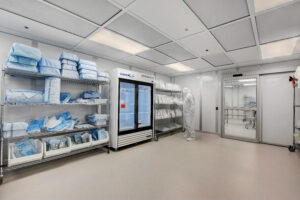Deciphering Cleanroom Classifications: A Guide to Understanding Standards
In the intricate world of cleanrooms, where precision and purity reign supreme, understanding the classification system is paramount for professionals involved in modular building enclosures and cleanrooms. These classifications are not just arbitrary categories but are essential in defining the level of cleanliness and control within these specialized environments. This blog post aims to demystify cleanroom classifications, providing a clear understanding of what each level signifies and its implications for various industries.
The Foundation of Cleanroom Classifications
At the heart of cleanroom classifications lie the ISO 14644-1 standards, a series that has become the global benchmark for cleanroom contamination control. Prior to the adoption of ISO 14644-1, the Federal Standard 209E (FS 209E) was widely used, especially in the United States. While FS 209E is now considered obsolete, its terminology is still commonly referenced in the industry.
ISO 14644-1 classifications range from ISO 1 to ISO 9, with ISO 1 representing the cleanest environments and ISO 9 the least stringent. The classification is determined based on the concentration of particles (measured in particles per cubic meter) of specific sizes in the air.
Understanding ISO 14644-1 Classifications
- ISO 1: The zenith of cleanroom standards, ISO 1, demands less than 10 particles of size 0.1µm per cubic meter. This extreme level of cleanliness is essential for industries where even the smallest particle can disrupt highly sensitive processes, such as in certain semiconductor and nanotechnology applications.
- ISO 2 to ISO 4: These classifications are often required in industries like pharmaceuticals, biotechnology, and high-end electronics manufacturing, where sterility and particle control are critical to product integrity and functionality.
- ISO 5 to ISO 7: Common in medical device manufacturing, aerospace, and some food processing applications, these classes balance stringent particle control with practical operational demands.
- ISO 8 to ISO 9: While still controlled environments, these classifications are less stringent and can be found in industries where a clean but not ultra-pure environment is sufficient. This includes some types of scientific research, less sensitive electronics assembly, and certain packaging processes.
The Transition from FS 209E to ISO 14644-1
For those familiar with the FS 209E standard, the transition to ISO classifications can be confusing. FS 209E classified cleanrooms from Class 1 (the cleanest) to Class 100,000, based on the number of particles 0.5µm or larger per cubic foot of air. The ISO standard, however, uses a more comprehensive approach, considering a wider range of particle sizes and providing a more detailed picture of the cleanroom environment.
The Impact of Cleanroom Classifications on Design and Operation
Understanding the required cleanroom classification is crucial in the design phase of a modular cleanroom project. It influences everything from the choice of materials and HVAC systems to the layout and airflow patterns. For instance, achieving an ISO 1 classification may necessitate specialized filtration systems, such as ULPA filters, and sophisticated airflow management to prevent any contamination.
Moreover, the classification impacts the operational protocols within the cleanroom. This includes gowning procedures, cleaning protocols, and monitoring requirements to maintain the specified level of cleanliness. The higher the classification, the more stringent these protocols become.
Conclusion
Cleanroom classifications serve as a critical guidepost in the design, construction, and operation of these specialized environments. They ensure that cleanrooms meet the exacting standards required by the industries they serve, from pharmaceuticals to aerospace. For professionals in the field of modular building enclosures and cleanrooms, a deep understanding of these classifications is essential. It not only aids in meeting regulatory requirements but also in achieving the ultimate goal of any cleanroom: to control contamination and ensure the integrity of the processes and products within. As technology advances and industries evolve, the importance of adhering to and understanding these classifications will only grow, underscoring their role in the foundation of cleanroom design and operation.

